CBSE Class 6 Science Notes Chapter 14 Water
Water cycle: It is circulation of water through the process of evaporation or condensation as rain or snowfall. Water cycle is like a ring. In nature, the water cycle takes place from sea to land and back to sea again.
Three States of Water
- Water can exist in all the three states—solid, liquid and gas.
- Liquid state: The water that we use in everyday life is a liquid. It is called liquid state of water.
- Gaseous state: We have learnt that on heating, water evaporates to form its vapour. Water vapour is its gaseous state.
- Solid state: Water turns into ice on cooling. Ice is the solid form of water.
- These three states of water are interconvertible to each other, that is, we can change it from one state to another.

The easy interconvertibility of water from one state to other makes its availability in all parts of the earth and throughout the year.

Evaporation
- The process of changing water to its vapour form is known as evaporation.
- Evaporation takes place from open surfaces of water all the time—day and night.
- Evaporation of water takes place continuously from oceans, rivers, lakes, wells and soil. Oceans, seas, rivers, lakes, ponds and wells together are often known as water bodies.
- During the day time, sunlight falls on the water in oceans, rivers, lakes. The fields, roads, rooftops and other land areas also receive sunlight. The sunlight also carries heat with it. As a result, water from oceans, rivers, lakes and the soil, and other land areas gets continuously changed into vapour.
- Thus, water vapour gets continuously added to air due to evaporation.
Transpiration
- Transpiration: It is the loss of water from the leaves of plants in the form of vapour.
- Every plant, whether it is in a crop field, a forest, on the roadside or in a kitchen garden, transpires to give off water vapour. The amount of water vapour that goes into air through the process of transpiration is very huge.
Condensation
- Condensation: The process of conversion of vapour into liquid form of water is called condensation.
- The process of condensation is opposite to evaporation.
Cloud formation: The climate close to the earth’s surface is warm. It gets cooled as one goes up in atmosphere. Water vapour being lighter, rises up in the atmosphere. At the upper layer of atmosphere, where the temperature is lower, the vapour gets condensed into tiny water droplets and forms clouds.
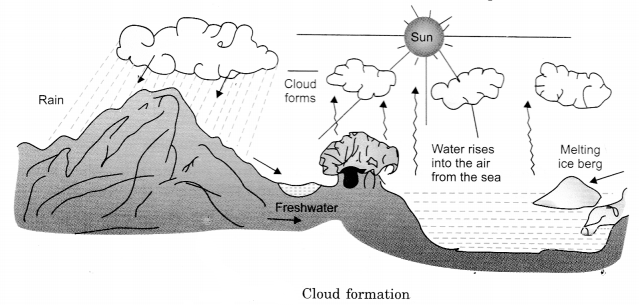
Precipitation
- Precipitation: Clouds carry small droplets of water in them. It may so happen that many droplets of water come together to form larger sized drops of water. Such drops of water may become so heavy that they begin to fall. Falling of water drops is called precipitation.
- Rain: If the water during precipitation remains liquid till it reaches the surface of the earth, we have rains.
- Hail/Snow: Sometimes precipitation may be in the form of hail or snow. Water in a hail or snow is in its frozen or solid form.
- Dew: Many times, especially during winter nights, the air near the surface becomes quite cool. As a result, the water vapour present in it condenses to form water droplets. These water droplets appear as dew.
Water Back to Ocean
The water that falls on the land as rain and snow sooner or later goes back to oceans. This may happen in many ways.
Uses of Water
- It is needed for drinking, bathing, washing, cleaning of vessels, toilets, flushing, etc.
- Our body contains about 70 per cent of water. Therefore, water is essential for our life.
- Water helps animals and plants to cool.
- Water is essential for the germination of seeds.
- Water is required for irrigation of the crops.
- Water is used to generate electricity.
- Water wheel is used to run flour mills.
- Water is used in many industries, like paper, rayon, petroleum refining, fertilizers, dyes, drugs and other chemical industries.
- Water is used in car radiators to keep the engine cool.
- In cold countries, people use water to warm their houses.
- Water is used to keep the things cool.
Sources of Water
Rivers and springs: Most of the water which human beings use for drinking, washing and farming comes from rivers and springs. The river flows down the mountain side and across the land, finally flowing into a sea or an ocean.
Oceans and seas: Most of the water on the earth is found in the oceans and seas. However, the water found in the oceans and seas is not fit for drinking or agricultural purposes as it contains large amount of salt. However, ocean acts as a habitat for large number of plants and animals.
Snow: Some regions of the earth are covered with snow especially during winters. Water formed by melting of snow is another source of water. This snow melts slowly. Sometimes this water flows down in the form of streams and rivers. Streams and rivers are another sources of water.
Groundwater: The ground water is actually rainwater which mainly comes from seepage of water accumulated under the ground. Figure 14.3 shows the accumulation of groundwater.
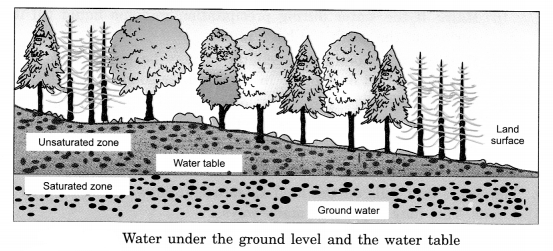
Water table: If you take soil from ground, it has air as well as water. As you go down, the amount of water increases and air decreases. A level below surface, where it is only water, is called the water table.
Lakes and ponds: These are small reservoirs of water. These are created by Collection of rainwater in low lying areas. Seepage from the groundwater reserves also adds to the water in lakes and ponds.
Rain: The rain is a very important source of water for us. All resources of water are fed mainly by rains.
Natural Calamities
The conditions of flooding and drought are called natural calamities.
Drought: If it does not rain for a year or more at a place, the soil will lose its water by evaporation and becomes dry. Water will also be lost through transpiration process from the plants. Rivers, ponds and wells will dry and the water table would lower down. All this will affect the humans, animals and wild plants. If it continues for one or two years consecutively, it results into drought.
Consequences of drought: The result of drought may be no crops. The availability of food and fodder will decrease. The overall consequence of such a situation will lead to loss of life of humans and animals.
Flood: In case of continuous rains, the water level of rivers, lakes and ponds will rise. The soil surface will get laden with water resulting into flood. Consequences of flood: When the soil gets too much of water, air in the soil comes out of it. Due to lack of air, the animals living inside the soil also come out of it. Heavy rainfall also results in the loss of crops due to flood.
Factors responsible for flood: A number of factors are responsible for flood. These factors can be intensity and duration of rainfall, soil condition and presence of plants or trees on the ground.
Water Conservation
- It is very important that water should be used carefully. We should take care that water should not get wasted.
- It is not necessary that the water used in the garden is fit for drinking. Yet most often we water the gardens with drinking water supplied by the corporation. We should use water for gardening that has already been used in the kitchen for washing vegetables and fruits, etc.
- Always be careful that the water tank in your house doesn’t overflow when it is being filled.
- Don’t use a hose pipe to wash your car or scooter. Use a bucket instead.
- If you leave the tap running while brushing your teeth, about 16 litres of water get used up. Fill a mug with water and use instead.
Rainwater Harvesting
- Water harvesting is the activity of collection of rainwater directly by various means.
- Harvested water can either be used immediately or it can be stored for later use.
- In Kerala and Mizoram, where it rains almost the whole year round, small tanks are used to collect rainwater, which drains from rooftops through pipes into these tanks. This water is used directly.
- In a place like Delhi where the monsoon lasts only for 3 months, it is more useful to collect rainwater as groundwater.
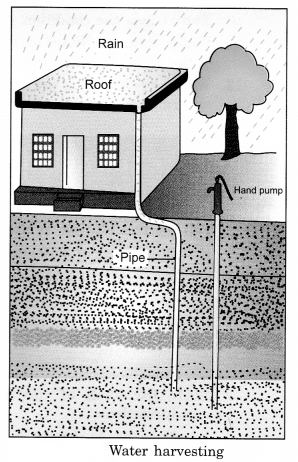
Water vapour: The gaseous form of water is called water vapour.
Clouds: When water vapour goes up where temperature is low it gets condensed into tiny water droplets and forms clouds.
Condensation: The process of conversion of vapour into liquid form of water is called condensation.
Drought: If it does not rain for one or two years consecutively at a place, it is known as drought.
Evaporation: Process of conversion of water into water vapour is called evaporation.
Flood: In case of continuous rains for long time at a place, it will result into the rise in the water level of rivers, lakes and ponds. The soil surface will get laden with water resulting into flood.
Groundwater: The groundwater is actually rainwater which mainly comes from seepage of water, accumulated under the ground.
Hail: Sometimes during precipitation of water droplets, water freezes, and takes the form of hail.
Ocean: Ocean is the biggest body of water surrounding the globe.
Rainwater harvesting: Rainwater harvesting is the activity of collection of rainwater by various means.
Snow: It is the condition similar to the formation of hail.
Water vapour: Water exists in three forms—solid, liquid and gas. Gaseous form of the water is called water vapour.
Water cycle: It is the circulation of water through the process of evaporation and rain or snowfall.
Water Available For Use
About three-fourth of the Earth’s surface is covered with water. That is why it is also called the water planet. But do you know how much water is readily available for use? Most of the water (about 97%) is in the seas and oceans as salt water. This water is too salty to be used for drinking and irrigation. Thus, only a tiny fraction (about 3%) of the Earth’s water is available to us as freshwater. Out of this, 2.997% is locked up in the mountains or glaciers or is buried so deep under that it costs too much to extract.
So, only about 0.003% of the fresh water is easily available to us in the form of groundwater, river, lake, stream, soil moisture, and water vapour. See Figure 15.1.

Uses Of Water
Besides being essential for life, water is used for many other purposes. In India, about 70% of the total water available is used for agriculture, 20-22% by industries and only 8% is used for personal or domestic needs. Figure 15.2 shows a pie chart that gives the percentage use of water.
Let us learn more about the various uses of water.
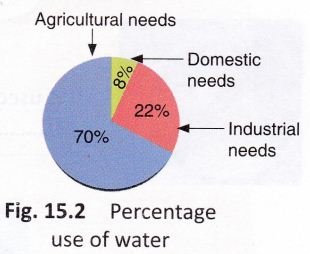
Agricultural needs Our country depends a lot on agriculture. Farmers rely on water to sustain their agricultural crops, e.g., wheat, paddy, etc. Many times, rainfall is not sufficient to water these crops, and farmers have to use artificial watering systems, referred to as irrigation.

Industrial needs Factories use a large amount of water every day—as raw material, for cleaning, heating, cooling, generating electricity (e.g., water turbines), etc. The amount of required depends on the kind and size of the factory, and water.
Personal/domestic needs We need water to drink. Water that is suitable for drinking is called potable water. We also need water to bathe, wash clothes and dishes, clean our house, and to water plants.
Apart from these uses, water is also used for transportation and recreation (Fig. 15.6). It also regulates the climate of a place and provides homes to many animals.

Different States Of Water
In nature, water exists in three states. It could be in the form of liquid (e.g., rain, river, sea), solid (e.g., ice, snow, hail), or gas (e.g., water vapour) (Fig. 15.7).
You can heat water over a stove to convert it into vapour. What happens if you leave water in an uncovered vessel on a summer afternoon outside your house? After a few hours, you will find that the level of water in the vessel has decreased. This is because a lot of it would have escaped into the atmosphere in the form of water vapour. The process by which a liquid is converted to its vapour is called evaporation.
What about the reverse process? The process by which the vapour of a substance is converted to its liquidform is called condensation. Water vapour is also added into the air by the leaves of plants, through the process of transpiration.
Evaporation and condensation of water take place on a very large scale on the surface of the Earth and its atmosphere. These processes play a key role in cloud formation and rain.

Cloud Formation
When the temperature of air increases, it expands (i.e., its particles move away from one another). This makes the air lighter and it rises in the atmosphere, taking water vapour with it. As the air rises, it begins to cool. The water vapour condenses on dust particles present in the atmosphere to form millions of tiny droplets. Tiny ice crystals will be formed instead if it is very cold. This cluster of tiny water droplets floating in the air is what we call a cloud.
Water Cycle
Water droplets in the clouds keep bumping against one another and sometimes stick to form bigger drops. When these drops become too heavy to float in the air, they drop down back to the Earth as rain. The water that comes down as rain, in time, evaporates and goes up to form clouds again. This leads to forming a cycle, known as the water cycle.
The water cycle is the cyclic movement of water from the atmosphere to the Earth and back to the atmosphere through various processes.
Figure 15.9 shows how the water cycle works.
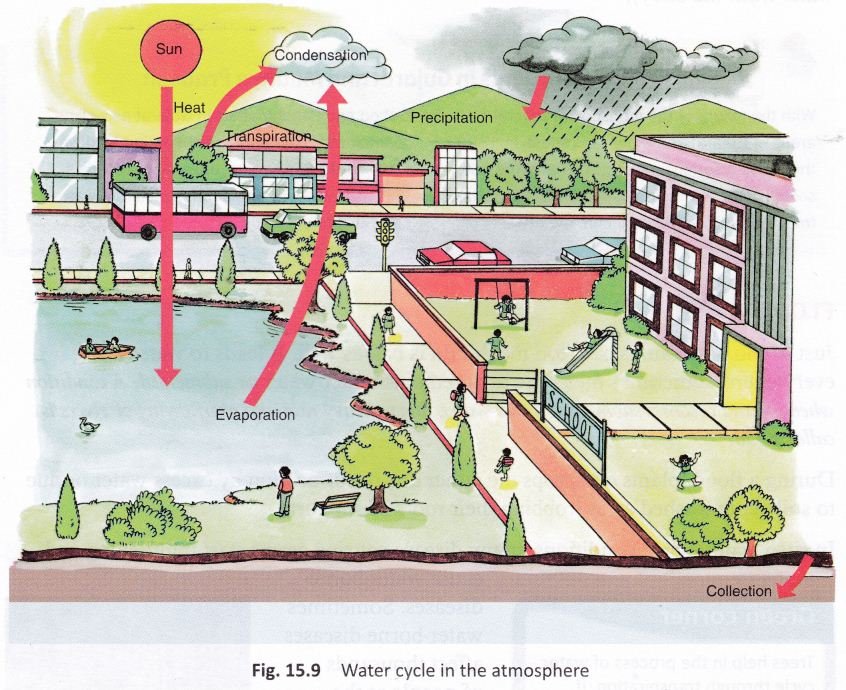
Evaporation Sun’s heat changes the water in oceans, rivers, ponds, and other water bodies into water vapour. Transpiration Plants give off water vapour through their leaves.
Condensation Water vapour rises up and condenses on dust particles to form clouds.
Precipitation Water stored in clouds reaches Earth in the form of rain, snow, etc.
Collection Some rainwater seeps into the ground, forming groundwater. Rainwater also flows into streams and rivers and then finds its way into seas and oceans.
Drought
Sometimes it does not rain for a long time—for an entire month, two months, the whole season, two years, etc. The abnormally long period of insufficient or no rainfall at all is called drought. During drought, rivers run dry, the water level in lakes goes down, and even the water in the soil dries up (Fig. 15.10).

There is very little or no water available during a drought. Most plants die leading to a lack of food in the region. The lack of food in a region for a long period is called famine. When there are no plants, animals that survive on plants also die. Animals and humans also die due to thirst and dehydration (excessive loss of water from the body).
Flood
Just as too little rain is bad, too much rain is bad as well. It leads to water being everywhere, sometimes the entire area remains under water or submerged. A condition when the ground becomes submerged under water, due to heavy rain and overflowing of rivers is called flood.
During a flood, plants and crops die either due to suffocation by excess water or due to the soil being washed away, robbing their roots of support.

In such waterlogged conditions, many disease-causing germs start multiplying and
cause water-borne diseases. Sometimes water-borne diseases affect thousands of people at the same time. A disease affecting thousands of people at the same time is called an epidemic.
A flood can thus lead to many conditions—disease, starvation, loss of life, and property. A flood also can have the same effect on the food chain as a drought does.
Both drought and flood are natural disasters—unfortunate events brought about by nature—that can have a very strong effect on the lives of people. The economy of a country can crumble as a result of the loss of property and life and many more things. But we can and must try to reduce the bad effects of these disasters as much as possible. We must understand that such things can happen, and so we must be prepared to face them as and when they happen.
Conservation Of Water
Since only a small percentage of water on our planet is usable, it is very important that we use water carefully. Conservation of water can be done by building dams, avoiding wastage of water at homes, both indoors and outdoors, harvesting rainwater, and preventing pollution of water.
Building Dam
A dam is a structure built to hold back water in order to prevent floods, and to provide water for irrigation and storage.
Building a dam is a solution to both drought and flood (Fig. 15.12).
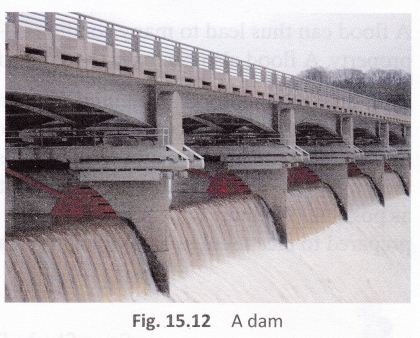
Dams are also used in producing electricity. Built on rivers, a dam has high walls and has many openings or gates to both let in and hold back water.
During heavy rainfall, when the rivers fill up, water enters the dam. When water is needed later, the gates are opened to let out water.
Avoiding Wastage at Homes
Some ways to avoid wastage of water at homes are given below.

Rainwater Harvesting:
The process of collecting and storing rainwater from roofs or a surface catchment is called rainwater harvesting (fig. 15.14). Storing rainwater that collects on roofs instead of letting it go down the drain, is a practical solution in case of droughts. This technique is known as rooftop rainwater harvesting. This involves collecting rainwater from rooftops in dugout ponds, vessels, or underground tanks to store water for long periods. Another option is to allow water to go into the ground directly from the roadside drains that collect rainwater. The stored rainwater is treated before use because it may contain bird faeces, chemicals, and other pollutants, which need to be removed before use.

Preventing Water Pollution:
Another method to conserve water is to safeguard our freshwater bodies from pollution. Garbage and harmful chemicals pollute the water and make it unfit for use. Polluted water (Fig. 15.15) is also very bad for aquatic life. Plants and animals in and around polluted water may die or get infected. And when human beings consume contaminated fish, etc., they are also put at risk of diseases.

Saltwater: Water of the seas and oceans that has high salt content, making it unfit for drinking and irrigation, is called salt water.
Freshwater: Water found in rivers, lakes, and ponds used for domestic and commercial purposes is called fresh water.
Irrigation: Watering crops by artificial means is called irrigation.
Potable water: Water fit for human consumption is called potable water.
Transpiration: The release of water vapour into the atmosphere through the leaves of plants is called transpiration.
Water cycle: The cyclic movement of water from the atmosphere to the Earth and back to the atmosphere through various processes is called the water cycle.
Drought: Abnormally long period of insufficient or no rainfall is called drought.
Famine: Lack of food in a region for a long period is called famine.
Flood: A condition when the ground becomes submerged under water, due to heavy rain and overflowing of rivers is called flood.
Epidemic: A disease affecting thousands of people at the same time is called an epidemic.
Dam: A structure built on a river to store and hold back water is called a dam.
Rainwater harvesting: The process of collecting and storing rainwater from roofs or a surface catchment is called rainwater harvesting.
Only a tiny fraction of the Earth’s water is available as fresh water. All living things have a lot of water in their body. Almost 70% of our body weight contains water.
We need water for many purposes—drinking, personal needs, agricultural needs, industrial needs, for transportation and recreation, and regulating the climate. It is home to various plants and animals.
Water exists in solid, liquid, and gaseous states.
Evaporation and condensation play an important role in cloud formation.
The water cycle is the cyclic movement of water from the atmosphere to the Earth and back to the atmosphere through various processes.
The abnormally long period of insufficient or no rainfall is known as drought.
When there is too much rainfall in an area, rivers overflow and water cover all the area around. This is called a flood. A flood can cause great destruction.
Rainwater harvesting is one of the ways to conserve water.